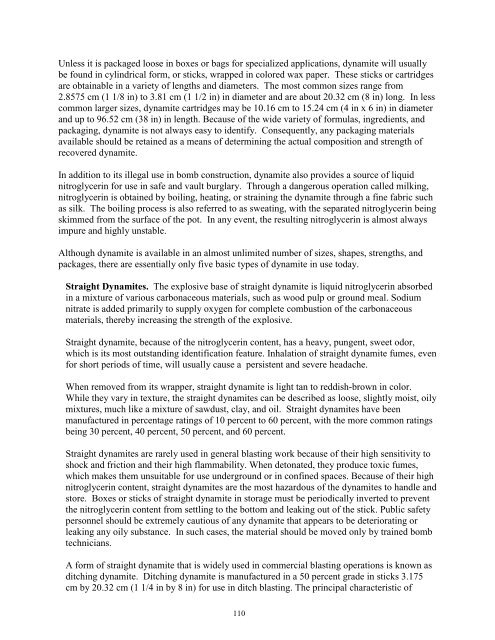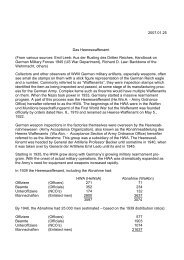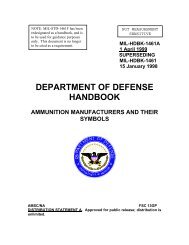Explosives-Nature, Use, Effects and Application.pdf
Explosives-Nature, Use, Effects and Application.pdf
Explosives-Nature, Use, Effects and Application.pdf
Create successful ePaper yourself
Turn your PDF publications into a flip-book with our unique Google optimized e-Paper software.
Unless it is packaged loose in boxes or bags for specialized applications, dynamite will usually<br />
be found in cylindrical form, or sticks, wrapped in colored wax paper. These sticks or cartridges<br />
are obtainable in a variety of lengths <strong>and</strong> diameters. The most common sizes range from<br />
2.8575 cm (1 1/8 in) to 3.81 cm (1 1/2 in) in diameter <strong>and</strong> are about 20.32 cm (8 in) long. In less<br />
common larger sizes, dynamite cartridges may be 10.16 cm to 15.24 cm (4 in x 6 in) in diameter<br />
<strong>and</strong> up to 96.52 cm (38 in) in length. Because of the wide variety of formulas, ingredients, <strong>and</strong><br />
packaging, dynamite is not always easy to identify. Consequently, any packaging materials<br />
available should be retained as a means of determining the actual composition <strong>and</strong> strength of<br />
recovered dynamite.<br />
In addition to its illegal use in bomb construction, dynamite also provides a source of liquid<br />
nitroglycerin for use in safe <strong>and</strong> vault burglary. Through a dangerous operation called milking,<br />
nitroglycerin is obtained by boiling, heating, or straining the dynamite through a fine fabric such<br />
as silk. The boiling process is also referred to as sweating, with the separated nitroglycerin being<br />
skimmed from the surface of the pot. In any event, the resulting nitroglycerin is almost always<br />
impure <strong>and</strong> highly unstable.<br />
Although dynamite is available in an almost unlimited number of sizes, shapes, strengths, <strong>and</strong><br />
packages, there are essentially only five basic types of dynamite in use today.<br />
Straight Dynamites. The explosive base of straight dynamite is liquid nitroglycerin absorbed<br />
in a mixture of various carbonaceous materials, such as wood pulp or ground meal. Sodium<br />
nitrate is added primarily to supply oxygen for complete combustion of the carbonaceous<br />
materials, thereby increasing the strength of the explosive.<br />
Straight dynamite, because of the nitroglycerin content, has a heavy, pungent, sweet odor,<br />
which is its most outst<strong>and</strong>ing identification feature. Inhalation of straight dynamite fumes, even<br />
for short periods of time, will usually cause a persistent <strong>and</strong> severe headache.<br />
When removed from its wrapper, straight dynamite is light tan to reddish-brown in color.<br />
While they vary in texture, the straight dynamites can be described as loose, slightly moist, oily<br />
mixtures, much like a mixture of sawdust, clay, <strong>and</strong> oil. Straight dynamites have been<br />
manufactured in percentage ratings of 10 percent to 60 percent, with the more common ratings<br />
being 30 percent, 40 percent, 50 percent, <strong>and</strong> 60 percent.<br />
Straight dynamites are rarely used in general blasting work because of their high sensitivity to<br />
shock <strong>and</strong> friction <strong>and</strong> their high flammability. When detonated, they produce toxic fumes,<br />
which makes them unsuitable for use underground or in confined spaces. Because of their high<br />
nitroglycerin content, straight dynamites are the most hazardous of the dynamites to h<strong>and</strong>le <strong>and</strong><br />
store. Boxes or sticks of straight dynamite in storage must be periodically inverted to prevent<br />
the nitroglycerin content from settling to the bottom <strong>and</strong> leaking out of the stick. Public safety<br />
personnel should be extremely cautious of any dynamite that appears to be deteriorating or<br />
leaking any oily substance. In such cases, the material should be moved only by trained bomb<br />
technicians.<br />
A form of straight dynamite that is widely used in commercial blasting operations is known as<br />
ditching dynamite. Ditching dynamite is manufactured in a 50 percent grade in sticks 3.175<br />
cm by 20.32 cm (1 1/4 in by 8 in) for use in ditch blasting. The principal characteristic of<br />
110




